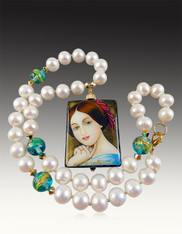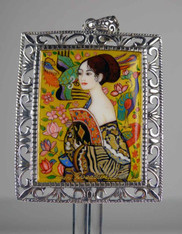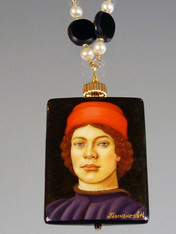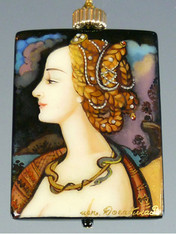 Loading... Please wait...
Loading... Please wait...Categories
Hand Painted Ingres Portrait of Louise de Broglie
Product Description
The Portrait of Comtesse d'Haussonville* is an 1845 oil on canvas painting by the French Neoclassical artist Jean-Auguste-Dominique Ingres. Hand painted in Russia with a 14K corrugated bead, 16mm hand knotted white pearls, Venetian glass blue gold foil stations and Swarovski crystals. 17-1/2" Pendant 2"
*The sitter was Louise de Broglie, Countess d'Haussonville, of the wealthy House of Broglie. The Princesse de Broglie, whom Ingres later portrayed c. 1851–53, was married to Louise's brother Albert de Broglie, the French monarchist politician, diplomat and writer.[1] Highly educated, Louise de Broglie was later an essayist and biographer, and published historical romance novels based on the lives of Lord Byron, Robert Emmett and Margaret of Valois.[2]
The painting is one of the few portrait commissions Ingres accepted at the time, as he was more interested Neoclassical subject matter, which to his frustration was a far less lucrative source of income than portraiture. He had made a preparatory sketch and had begun an oil and canvas version two years earlier, but abandoned the commission when de Broglie became pregnant and was no longer able to pose for the long periods he required, and she had anyway found interminable and "boring". The final work is signed and dated at the lower left.[2]
The painting is composed from pale blue, grey, brown, gold and white hues. Mme. de Broglie is shown fully frontal, looking out at the viewer with a demure expression, the intensity of which has often been compared to his later portrait of Madame Moitessier.[7] Ingres reintroduces a motif first seen in his 1814 Portrait of Madame de Senonnes, that of the central figure reflected in a background mirror.
She wears a heavily folded cold grey-blue satin dress, painted with the same hue as her eyes. Her hair is parted and topped with a crimson ribbon at the back. The dresser before the mirror contains a variety of writing materials, pots and flowers, and a lavishly decorated oriental vase. The central motif of both the final painting and its predecessors is her raised left hand index finger, coyly placed by her mouth, and her sinuous, unnaturally elongated right arm.[2]
The painting was exhibited at the 1846 Bonne-Nouvelle exhibition alongside Ingres' 1814 Grande Odalisque and 1842 Odalisque with Slave, where all three works were praised by the French poet Charles Baudelaire for their "voluptuousness"; after the show he described Ingres as the quintessential painter of women, and described such portraits as the artist's highest accomplishments.[8]
Provenance[edit]
The painting remained in the family's private possession for eighty years, though it was displayed publicly on occasion. Its first Paris exhibition in 1846 created "a storm of approval among her family and friends", Ingres wrote a friend.[9] The portrait was subsequently exhibited in 1855, 1867, 1874, and 1910, and was engraved in 1889 and again in 1910; it was also circulated in photographed form.[10]
Following the death of Paul-Gabriel d'Haussonville in 1924, his descendants sold the painting to offset estate taxes[11] to art dealer Georges Wildenstein,[12] from whom it was next acquired by the Frick Collection for $125,000 in 1927.[13] It has been almost continuously on public display in New York since the opening of Henry Clay Frick's home as a museum in 1935. Unlike other works acquired directly by Frick, Comtesse d'Haussonville can be loaned and exhibited elsewhere.[13]











